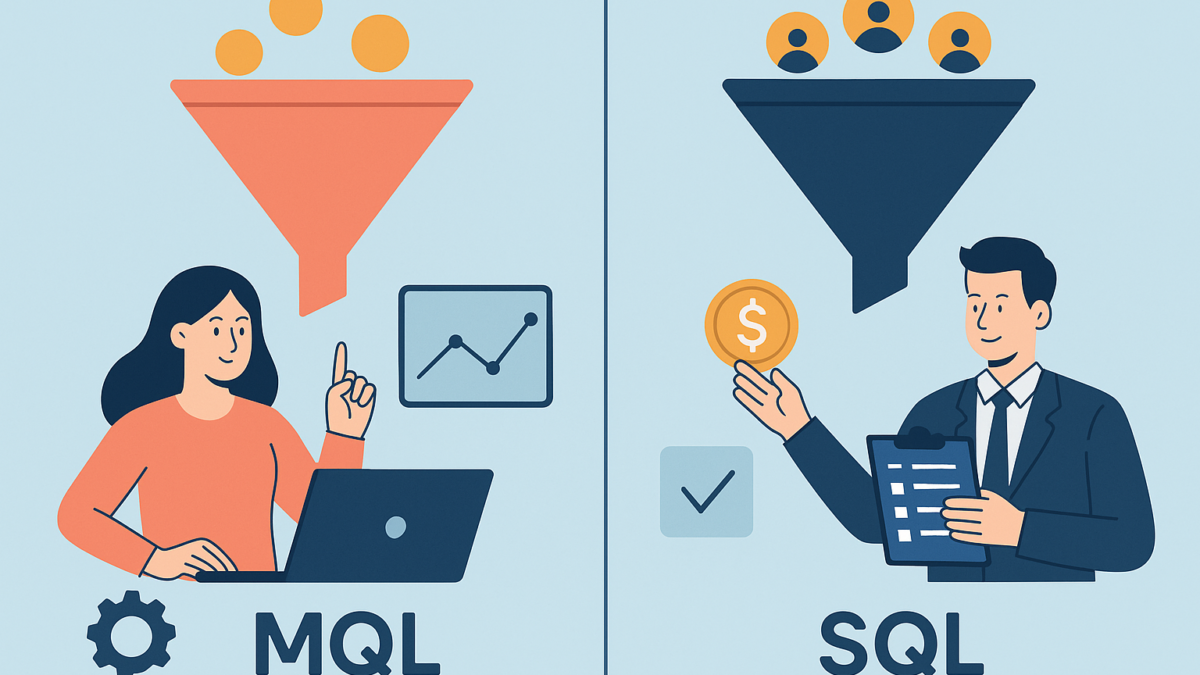MQL vs SQL: Understanding the Real Difference for Better B2B Conversions in 2025
Table of Contents
Introduction
In the ever-evolving world of B2B marketing and sales, identifying the right moment to engage a lead is crucial. One of the most persistent challenges? Knowing the difference between MQLs (Marketing Qualified Leads) and SQLs (Sales Qualified Leads)—and using that distinction to drive better conversions.
As automation, AI, and personalization transform the buyer journey in 2025, the line between MQL and SQL becomes even more critical to understand. Let’s break it down.
What Is an MQL (Marketing Qualified Lead)?
An MQL is a lead who has shown interest in your product or service based on marketing efforts—but is not yet ready to be contacted by sales.
Common MQL Behaviors:
- Downloading a whitepaper or eBook
- Subscribing to a newsletter
- Attending a webinar
- Visiting product or pricing pages multiple times
- Engaging with blog content or LinkedIn ads
Characteristics of an MQL:
- Fits your Ideal Customer Profile (ICP)
- Demonstrates interest but not intent
- Needs further nurturing via email workflows, retargeting, or content
What Is an SQL (Sales Qualified Lead)?
An SQL is a lead that has been vetted—either by your marketing team, sales team, or automation—and is deemed ready for a direct sales conversation.
SQL Behaviors:
- Requesting a product demo
- Filling out a “contact sales” form
- Responding positively to outreach
- Showing purchase intent or urgency
Characteristics of an SQL:
- Meets BANT criteria (Budget, Authority, Need, Timeline)
- Likely to convert within a defined sales cycle
- Handled directly by the sales team
MQL vs SQL: Key Differences at a Glance
| Criteria | MQL (Marketing Qualified Lead) | SQL (Sales Qualified Lead) |
|---|---|---|
| Lead Source | Content downloads, ads, SEO, email | Inbound requests, referrals, SDRs |
| Intent Level | Interested but not purchase-ready | Actively considering purchase |
| Next Action | Continue nurturing | Move to sales engagement |
| Team Ownership | Marketing | Sales |
| Conversion Rate | Lower | Higher |
| Time to Close | Longer | Shorter |
Why This Matters in 2025
In today’s data-driven landscape, B2B buyers research independently, consuming up to 70% of content before speaking to sales (source: Forrester). This makes it essential to accurately score, segment, and qualify leads.
2025 Trends Impacting Lead Qualification:
- AI-driven lead scoring improves accuracy
- Intent data from platforms like Bombora helps identify SQLs earlier
- Hyper-personalization bridges the gap between MQL and SQL
- Sales and marketing alignment is more critical than ever
Read Also: How to Increase Sales Effectively: iTMunch Strategy for 2025
How to Transition an MQL to an SQL
Here’s a step-by-step guide:
- Lead Scoring: Assign point values for specific behaviors (e.g., visiting the pricing page = +20 points).
- Behavioral Tracking: Monitor touchpoints across the funnel (e.g., repeat visits, time spent on site).
- CRM Segmentation: Use platforms like HubSpot, Salesforce, or Zoho to tag and move leads through stages.
- Lead Nurturing Campaigns: Automate educational content, case studies, and webinars tailored to pain points.
- Trigger SQL Qualification: When behavior indicates readiness (e.g., requesting a demo), pass the lead to sales.
Real-World Example
A SaaS company offering cybersecurity tools classified all free trial users as SQLs. But many weren’t ready to buy, resulting in poor conversions. After restructuring their lead scoring model, they defined MQLs as users who completed 3+ sessions and downloaded the security checklist.
Result? A 24% increase in SQL-to-opportunity conversion rate.
Best Practices for Managing MQLs and SQLs
- Define your MQL and SQL criteria clearly with input from both sales and marketing.
- Revisit lead scoring models quarterly.
- Avoid passing MQLs to sales too early—it burns reps’ time and affects morale.
- Use a marketing automation platform to manage workflows and scoring (e.g., Marketo, Pardot, HubSpot).
- Align KPIs across both teams to reduce handoff friction.
Need help building an efficient MQL-to-SQL pipeline?
👉 Explore iTMunch’s Lead Generation Services
Align Your Funnel for Growth in 2025
Understanding the MQL vs SQL distinction isn’t just a technicality—it’s a strategic growth lever. Misaligned leads drain your pipeline. But with the right criteria, tools, and team alignment, you can drive smarter conversations, faster closes, and better ROI.
👉 Book a strategy call with our lead generation experts today and optimize your funnel from MQL to SQL.
Contact Us





